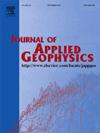非均质导电性磁化率层序叠置矿床航空物探数据序贯三维反演策略
IF 2.2
3区 地球科学
Q2 GEOSCIENCES, MULTIDISCIPLINARY
引用次数: 0
摘要
我们提出了一种针对机载电磁和磁勘测数据的顺序三维反演策略,用于搜索具有高电导率和磁感应强度特征的区域,以及这些区域与具有异质电导率和磁感应强度的地层重叠的情况。我们探讨了获得磁力勘测数据等效模型的可能性(即模型之间存在很大差异,但给出的数据响应相同)。结果表明,对于由异质(磁特性)层重叠的相对较深的岩体,只能对其磁感应强度进行上限估算。提出了电磁(EM)和磁数据的顺序三维反演策略。该策略的一个重要组成部分是两阶段三维电磁数据反演,可高精度重建异质导电层下局部导电体的几何形状和深度。该策略的最后阶段是确定已发现的局部体是否可能具有增强磁性。为了测试所提出的方法,我们使用了在克里顿地区(加拿大)为寻找多金属矿而进行的航空地球物理勘测数据。我们对不同飞行高度下的一个机载电磁勘测数据集和两个磁性勘测数据集进行了顺序三维反演。与钻探数据的比较表明,所提出的顺序三维反演策略不仅可以确定远景区,还可以改进钻井轨迹的规划。本文章由计算机程序翻译,如有差异,请以英文原文为准。
Sequential 3D inversion strategy of airborne geophysical survey data for exploration of ore mineral deposits overlapped by layers with heterogeneous conductivity and magnetic susceptibility
We present a sequential 3D inversion strategy for airborne electromagnetic and magnetic survey data when searching for areas characterized by high values of conductivity and magnetic susceptibility, in a situation where these are overlapped by layers with heterogeneous conductivity and magnetic susceptibility. We explore the possibility of obtaining equivalent models for magnetic survey data (i.e. models that are quite different from each other but give the same data responses). It is shown that for relatively deep bodies overlapped by heterogeneous (in magnetic properties) layers, only an upper estimate of their magnetic susceptibility is possible. A sequential 3D inversion strategy of electromagnetic (EM) and magnetic data is proposed. An important component of this strategy is a two-stage 3D EM data inversion, which allows the high-precision reconstruction of the geometry and depth of local conductive bodies underlying heterogeneous conductivity layers. The final stage of the strategy is to determine whether the discovered local bodies may have enhanced magnetic properties. To test the proposed approach, we use data from an airborne geophysical survey performed in the Creighton area (Canada) in search for polymetallic ores. The sequential 3D inversion is carried out for an airborne electromagnetic survey dataset and two magnetic survey datasets at different flying height levels. Comparison with drilling data indicates that the proposed sequential 3D inversion strategy allows not only identification of prospective areas, but also improves planning of well drilling trajectories.
求助全文
通过发布文献求助,成功后即可免费获取论文全文。
去求助
来源期刊

Journal of Applied Geophysics
地学-地球科学综合
CiteScore
3.60
自引率
10.00%
发文量
274
审稿时长
4 months
期刊介绍:
The Journal of Applied Geophysics with its key objective of responding to pertinent and timely needs, places particular emphasis on methodological developments and innovative applications of geophysical techniques for addressing environmental, engineering, and hydrological problems. Related topical research in exploration geophysics and in soil and rock physics is also covered by the Journal of Applied Geophysics.
 求助内容:
求助内容: 应助结果提醒方式:
应助结果提醒方式:


